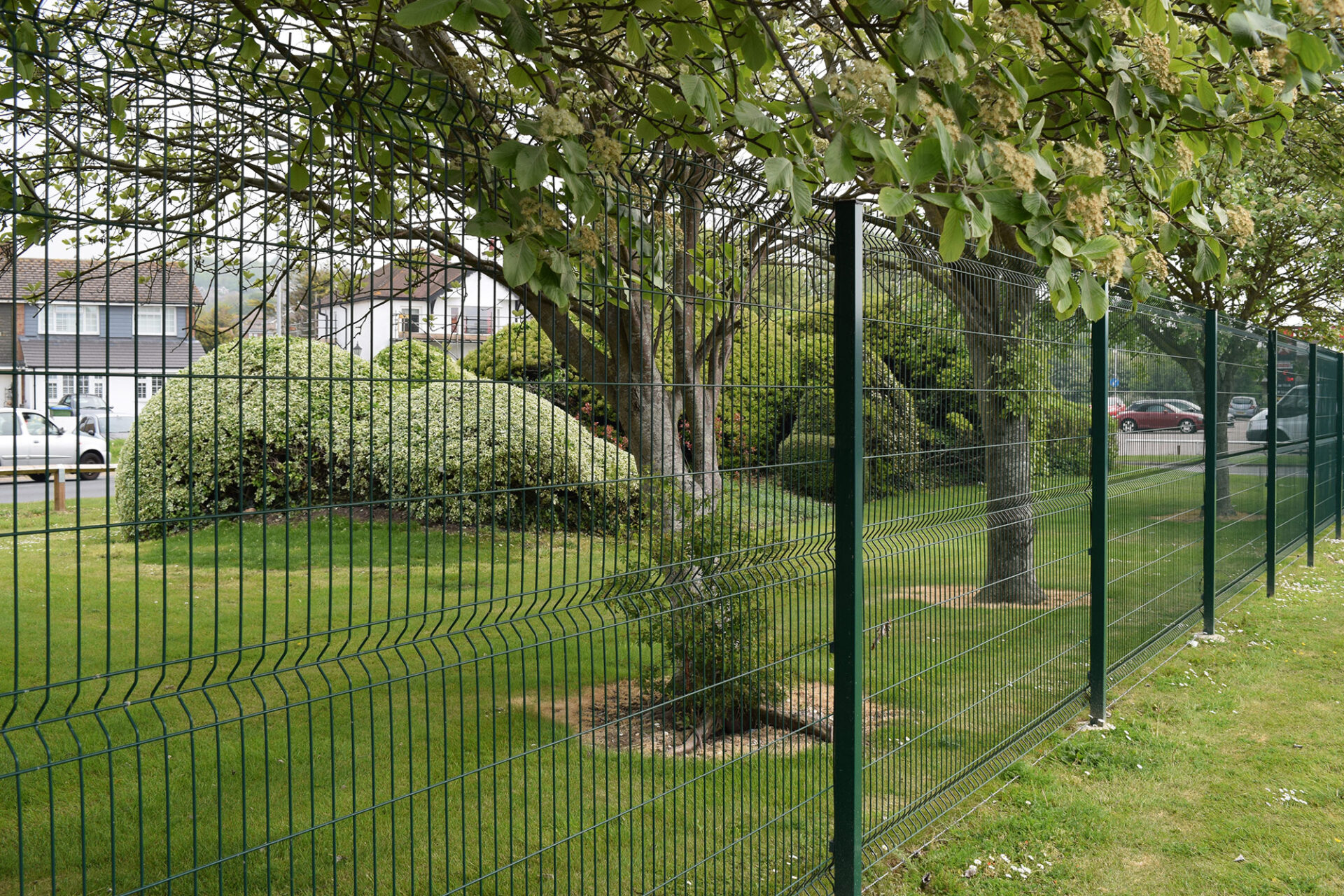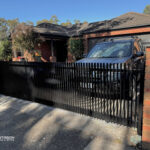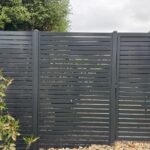
When it comes to choosing high-security fencing, there are various options available, but the two main choices are palisade security fencing and mesh security fencing. Both types of metal fences serve the purpose of protecting high-value assets and sensitive sites, although they offer different benefits.
Palisade and mesh security fences can be breached relatively quickly depending on the intruders’ experience and access to tools. As a result, they are often used as demarcation solutions rather than providing high-level security. However, both systems have high-security derivatives available.
In this blog, we will discuss the advantages and disadvantages of each fencing option to help you make an informed decision when specifying a metal high-security fence.
Security Mesh Security Fencing

Mesh security fencing has gained popularity since its introduction to the market in the early 1990s, primarily due to its aesthetic appeal compared to palisade fencing. It is commonly used around schools and commercial premises where a more friendly and decorative appearance is desired, thanks to its reduced steel content and less aggressive top line.
Similar to palisade fencing, mesh security fencing offers varying levels of security based on different configurations and specifications.
Advantages of High-Security Mesh Fencing
Visual Appeal
Mesh security fencing is considered more visually pleasing, making it suitable for installations in residential areas or locations where it is important to maintain an aesthetically pleasing environment. The reduced steel content and less aggressive design contribute to a fence that is more visually appealing and less disruptive to the general public.
Versatility on Flat Surfaces
Mesh security fencing is well-suited for flat surfaces as it comes in rigid panels. This makes installation easier and more efficient, particularly when compared to other fencing options that may require more complex adaptations to suit different terrains.
Cost-Effectiveness
Standard or demarcation mesh fencing is generally more affordable than standard palisade fencing. The reduced steel content in mesh fencing makes it a more economical choice. However, when comparing high-security derivatives of mesh and palisade fencing, the price difference may vary.
Additional Security Options
Mesh fencing can be easily upgraded with various security toppings to enhance its effectiveness. These can include barbed or razor wire, as well as electric pulse fencing, all of which serve as strong deterrents against trespassers trying to climb or breach the fence.
When selecting a fencing system, it is important to consider factors such as the desired level of security, the visual impact on the surrounding environment, cost considerations and any specific site requirements. Mesh security fencing offers an attractive alternative to palisade fencing, particularly in residential or public areas where aesthetics and community integration are important.
Disadvantage of Mesh Security Fencing
Vulnerability to Cutting
Contrary to popular belief, mesh fencing is not entirely “anti-climb.” One of the most straightforward ways to breach mesh fencing is by snipping the wires using basic hand tools. Intruders can create footholds or use common instruments like knives, forks or screwdrivers as climbing aids. This highlights the need for additional security measures, such as toppings, to deter climbing.
Pre-Galvanized Coating
Many mesh panels are pre-galvanized, which means they have a thinner zinc coating and may not provide long-term protection against the elements compared to hot-dipped galvanized finishes. To enhance durability and weather resistance, mesh security fencing often requires additional powder coating. However, this adds to the overall cost. While more expensive galfan panels with a longer lifespan are available, they are less common in the market.
Perceived Security
Mesh fencing’s visually appealing design can sometimes lead to the perception that it is less secure and easier to breach compared to palisade fencing. Standard clips and clamp bars on the front face of the fence can be vulnerable to attacks using hand and power tools. The relatively thin wires of the mesh can also be cut with small hand cutters, posing a security risk.
Complex Construction for Security Ratings
Achieving higher security ratings with mesh systems often requires the addition of accessories or double-skin panels. This results in more pieces to construct or larger and heavier pre-assembled components, making installation and handling more challenging. Moreover, the visibility through the panel may be compromised when accessories or double-skin layers are added.
Installation Challenges on Uneven Surfaces
Mesh panels are rigid, which can pose difficulties when installing them on uneven surfaces. It may result in gaps under the fence or require burying the fence in the ground and stepping it to accommodate the uneven terrain. This can slow down the installation process and add extra cost to the project.
Increased Cost for Upgrades
While standard mesh systems may be more economical initially, upgrading the security of the fence, such as adding anti-climb or anti-cut technologies to meet tested security ratings, can significantly increase the cost beyond what would be required for a comparable palisade system.
Considering these drawbacks, it is essential to assess the specific security needs, site conditions and budget constraints before deciding on the suitability of mesh security fencing as a security solution. Consulting with professionals in the field can help determine the best fencing option for a particular project.
High-Security Palisade Fencing

High-security palisade fencing has a long-standing history, having been in use for almost a century. It’s important to note that not all palisades are the same and there are various types available, each offering different levels of security. To address concerns and enhance security, high-security derivatives of palisade fencing have been developed. These advanced systems are designed to withstand physical attacks and intrusions, providing a robust and long-lasting barrier against potential intruders.
High-security palisade fencing is deployed worldwide to safeguard critical assets such as mineral mines, nuclear installations, data centers and numerous establishments categorized as Critical National Infrastructure (CNI) in the UK.
These high-security palisade fences incorporate additional features and enhancements to reinforce their resistance to breaches. They may include reinforced pales, strengthened fixings, anti-climb measures and increased overall durability. By deploying high-security palisade fencing, organizations can significantly enhance the protection of their valuable assets and sensitive sites. It is worth noting that the effectiveness of any high-security fencing system is not solely based on the type of fencing chosen but also on factors such as proper installation, maintenance and integration with other security measures.
High-security palisade fencing offers an effective and proven solution to protect critical infrastructure and high-value assets. By utilizing advanced designs and features, it serves as a formidable barrier against intrusions and physical attacks, providing peace of mind and safeguarding sensitive sites around the world.
Advantages of High-Security Palisade Fencing
High-security palisade fencing offers several advantages that contribute to its effectiveness as a formidable security solution. Here are some of the key benefits:
Intimidating Appearance
The design of palisade fencing, with its triple or single-pointed pales, creates an intimidating appearance. The fence can reach heights of up to 3.6 meters, deterring potential intruders from attempting to climb it due to the risk of getting caught or impaled. Additionally, security toppings can be added and an additional lift can increase the overall height of the palisade, further enhancing its deterrence factor.
Strong and Reinforced Construction
Palisade security fencing is constructed using robust steel pales that are often reinforced. The pointed tops not only serve as a visual deterrent but also make it challenging for attackers to break in, as they can clearly see the difficulty of gaining entry. Some clients opt for outward-curved pales to make the fence even more difficult to climb, adding an extra layer of security.
Ease of Installation
Palisade fencing is relatively easy to install and more convenient compared to its mesh security counterpart. It comes in individual pieces, making it easier to maneuver and assemble, as opposed to large mesh panels.
Adaptability to Contours
High-security palisade fencing can adapt to sloping ground contours of up to 30 degrees without requiring on-site modifications such as steps. This adaptability eliminates the need for obvious footholds and makes it difficult to create climbing aids within the structure.
Durable and Protective Coating
Palisade fencing is typically made from mild steel that undergoes hot-dip galvanization. This process provides a protective zinc coating, increasing the fence’s resistance to corrosion and extending its average lifespan to around 25 years. The zinc coating can be further enhanced by applying a polyester powder coating in any desired RAL color.
Specialized High-Load Fixings
High-security derivatives of palisade fencing utilize special high-load fixings and fasteners that are designed to withstand attacks from hand and power tools. These fixings meet the standards set for accreditation, ensuring enhanced security and strength. Additionally, high-security palisade systems eliminate post fasteners or fishplates that are considered potential weaknesses in standard versions.
By capitalizing on these advantages, high-security palisade fencing provides a robust and reliable solution for protecting sensitive sites and high-value assets, instilling a sense of security and deterring potential intruders.
Disavantage of Palisade Fencing
While palisade fencing offers various advantages, it also has some disadvantages that should be taken into consideration. Here are a few notable drawbacks:
Visual Intrusion
The formidable appearance of palisade fencing, with its pointed pales and imposing design, may be perceived as visually intrusive in certain settings, particularly in residential areas or locations where aesthetics are a concern. The aggressive look of palisade fencing may not align with the desired visual appeal of the surrounding environment.
Limited Transparency
Palisade fencing typically consists of solid steel pales, which can limit visibility both from inside and outside the fenced area. This reduced transparency can hinder surveillance efforts, making it more challenging to monitor activities on both sides of the fence.
Higher Cost
Compared to standard mesh security systems used for boundary demarcation, palisade fencing tends to be more expensive. The additional steel content in palisade fencing increases its cost, making it a less cost-effective option for some budgets.
Vulnerability of Pale Fixing
In standard versions of palisade fencing, the pale fixing can be a potential weakness. Intruders with knowledge and tools can easily remove pales, gaining unauthorized access to the protected area. This vulnerability can compromise the overall security of the fence and the site it is intended to protect.
It’s worth noting that advancements in design and technology have led to the development of high-security derivatives of palisade fencing that address some of these disadvantages. These specialized versions incorporate improved fixing systems, enhanced visibility options and alternative aesthetics to mitigate the drawbacks associated with standard palisade fencing. When considering palisade fencing as a security solution, it is essential to evaluate these disadvantages in relation to the specific requirements of the site and the desired level of security, aesthetics and functionality. Consulting with security professionals can provide valuable insights and help determine whether palisade fencing is the most suitable option for a particular application.
Conclusion
The choice between palisade and mesh security fencing ultimately depends on various factors such as operational requirements, budget, aesthetic considerations and desired security level. Each fencing system has its advantages and disadvantages and it’s crucial to carefully assess these factors before making a decision.
If you require further assistance or would like to discuss your specific operational requirements, it is recommended to get in touch with professionals in the field. They can provide expert guidance and conduct a site consultation to help determine the most suitable security fencing solution for your needs or the needs of your clients.




